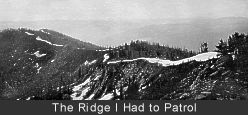| Chapter 7: Up the
Mountain
It was July 19th before it was considered necessary for me to assume my duties as fire lookout. Up to this time the winter's crop of snow was melting and the mountains were wet. Early in the morning we started up the mountain. I walked ahead with an axe. Whenever a fallen tree blocked our trail, it was my duty to clear the road. Mr. Agnew and Mr. Gilroy rode their horses and conducted pack horses. The horses rested while I chopped, and then I had to walk as fast as a horse. This trail led up and ever upward. Every time I thought the top in view, I would discover it a hoax. At last, at five o'clock P.M., I was told that I was on top of the ridge and could see the peak my shack was on. They pointed to a hump in the blue distance a good eight miles across a horseshoe-shaped ridge. We arrived that night. What I took for an outcrop of white quartz proved to be snow, and the apparent tropical temperature was actually some scant 60 degrees Fahr., the heat effect being due to the altitude of 7,000 ft. We found a glass-enclosed, tin-roofed shack, drift-bolted to the highest granite knob of the ridge. The shack was 12X12 ft., and it contained a plane table and a map oriented to the points of the compass so that I could give the exact direction of any fires I located, and telephone the information to O'Hara Bar to be relayed on if necessary. My duties were to report fires, to keep rainfall data, temperature data, wind velocity estimates and a report on haze at frequent intervals. I was given a portable telephone set, a pair of climbers, insulators and pliers to keep my 15 miles of telephone wire intact. The latter occupied much of my time, as trees were forever falling across it. It was also my duty to patrol the ridge for a distance of about five miles each way, daily. This would give me a look into the top of several gorges. |






